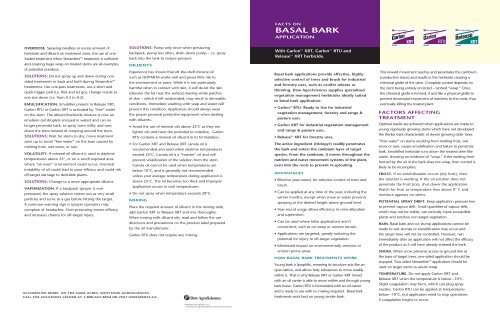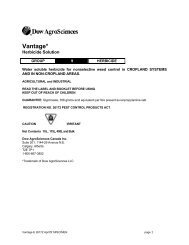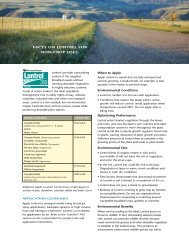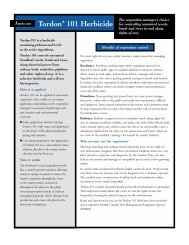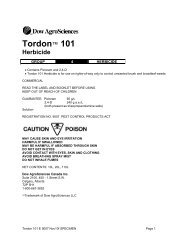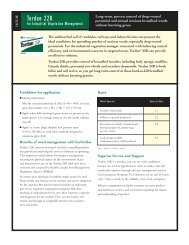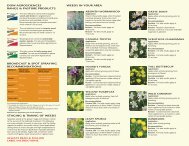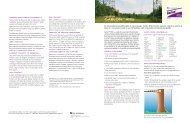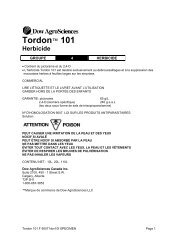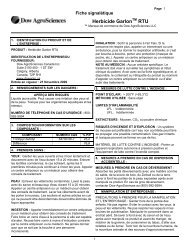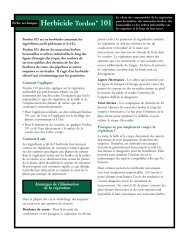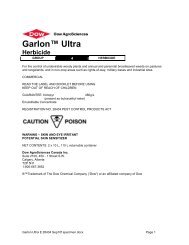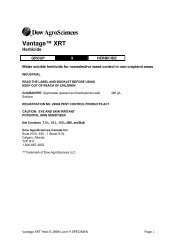Basal Bark Facts (English) - IVM Experts
Basal Bark Facts (English) - IVM Experts
Basal Bark Facts (English) - IVM Experts
Create successful ePaper yourself
Turn your PDF publications into a flip-book with our unique Google optimized e-Paper software.
FACTS ON<br />
BASAL BARK<br />
APPLICATION<br />
OVERDOSE. Spraying needless or excess amount of SOLUTIONS: Pump only once when pressuring<br />
herbicide and diluent on treatment zone, the use of one- backpack, pump less often, drain down pump – i.e. spray<br />
Ssided treatment when Streamline TM treatment is sufficient back into the tank to reduce pressure.<br />
and creating huge wrap on treated stems are all examples DILUENTS<br />
of potential overdose.<br />
Experience has shown that off-the-shelf mineral oil<br />
SOLUTIONS: Do not spray up and down during onesided<br />
treatments or back and forth during Streamline TM<br />
the environment or users. While it is not particularly<br />
such as ISOPAR ® M works well and poses little risk to<br />
treatments. Use one-pass treatments, use a short and harmful when in contact with skin, it will de-fat the skin<br />
quick trigger pull (i.e. flick and let go), change nozzle to (dissolve the fat near the surface) leaving white patches<br />
one size down (i.e. from 0.3 to 0.2).<br />
of skin – which if left unattended, may result in dermatitis<br />
EMULSIFICATION. Emulsifier present in Release XRT, conditions. Immediate washing with soap and water will<br />
Garlon RTU or Garlon XRT is activated by “free” water prevent this condition. Applicators should always wear<br />
on the stem. The diluent/herbicide mixture is now an the proper personal protective equipment when dealing<br />
emulsion (oil droplets encased in water) and can no with diluents.<br />
longer penetrate bark, so spray turns milky and runs • Avoid the use of mineral oils above 25°C as they are<br />
down the stem instead of creeping around the stem.<br />
lighter oils and have the potential to volatilize. Garlon<br />
SOLUTIONS: Wait for stems to dry; move treatment RTU contains a mineral oil diluent in its formulation.<br />
zone up to avoid “free water” on the base caused by<br />
• For Garlon XRT and Release XRT canola oil is<br />
melting frost, wet snow, or rain.<br />
recommended and used when daytime temperatures<br />
VOLATILITY. If mineral oil diluent is used in daytime exceed 25°C. Canola oil is a “heavier” oil and will<br />
temperatures above 25°, or on a south exposed area prevent volatilization of the solution from the stem.<br />
where “an oven” environment could occur, chemical Canola oil cannot be used when temperatures are<br />
instability of oil could lead to poor efficacy and could risk below 10°C, and is generally not recommended<br />
off-target damage to desirable plants.<br />
unless your average temperature during application is<br />
SOLUTIONS: Change to a more appropriate diluent. above 25°C. The oil becomes too thick and improper<br />
application occurs in cool temperatures.<br />
VAPORIZATION. If a backpack sprayer is over<br />
pressured, the spray solution comes out as very small • Do not spray when temperature exceeds 28°C.<br />
particles and turns to a gas before hitting the target. MIXING<br />
A common warning sign is sprayer operators may<br />
Place the required amount of diluent in the mixing tank,<br />
complain of headaches. Over-pressuring lowers efficacy<br />
add Garlon XRT or Release XRT and mix thoroughly.<br />
and increases chance for off-target injury.<br />
When mixing with diluent oils, read and follow the use<br />
directions and precautions on the product label prepared<br />
by the oil manufacturer.<br />
Garlon RTU does not require any mixing.<br />
ACCOMPLISH MORE. ON THE SAME ACRES. WITH DOW AGROSCIENCES.<br />
CALL THE SOLUTIONS CENTER AT 1.800.667.3852 OR VISIT <strong>IVM</strong>EXPERTS.CA.<br />
*Trademark of Dow AgroSciences LLC.<br />
TM ® All products are registered trademarks of their respective companies.<br />
With Garlon TM XRT, Garlon TM<br />
RTU and<br />
Release TM XRT herbicide.<br />
<strong>Basal</strong> bark applications provide effective, highly<br />
selective control of trees and brush for industrial<br />
and forestry uses, such as conifer release or<br />
thinning. Dow AgroSciences supplies specialized<br />
vegetation management herbicides ideally suited<br />
to basal bark application:<br />
• Garlon TM<br />
RTU- Ready to Use for industrial<br />
vegetation management, forestry and range &<br />
pasture uses.<br />
• Garlon XRT for industrial vegetation management<br />
and range & pasture uses.<br />
• Release TM<br />
XRT for forestry uses.<br />
The active ingredient (triclopyr) readily penetrates<br />
the bark and enters the cambium layer of target<br />
species. From the cambium, it moves throughout the<br />
nutrient and water movement systems of the plant,<br />
even into the roots to prevent re-sprouting.<br />
ADVANTAGES<br />
• Effective year-round, for selective control of trees and<br />
brush.<br />
• Can be applied at any time of the year, including the<br />
winter months, except when snow or water prevents<br />
spraying at the desired height above ground level.<br />
• Year-round usage allows efficiency in crew allocation<br />
and supervision.<br />
• Can be used where foliar applications aren’t<br />
convenient, such as on steep or uneven terrain.<br />
• Applications are targeted, greatly reducing the<br />
potential for injury to off-target vegetation.<br />
• Minimized impact on environmentally sensitive or<br />
erosion prone areas.<br />
HOW BASAL BARK TREATMENTS WORK<br />
Young bark is lipophilic, meaning its structure acts like an<br />
open lattice, and allows fatty substances to move readily<br />
within it. That is why Release XRT or Garlon XRT mixed<br />
with an oil carrier is able to move within and through young<br />
bark tissue. Garlon RTU is formulated with an oil carrier<br />
and is ready to use with no mixing required. <strong>Basal</strong> bark<br />
treatments work best on young tender bark.<br />
This inward movement reaches and penetrates the cambium<br />
(conductive tissue) and results in the herbicide creating a<br />
chemical girdle of the stem. Complete control depends on<br />
the stem being entirely encircled – termed “wrap.” Once<br />
the chemical girdle is formed, it acts like a physical girdle to<br />
prevent downward movement of nutrients to the roots, thus<br />
eventually killing the treated plant.<br />
FACTORS AFFECTING<br />
TREATMENT<br />
Optimal results are achieved when applications are made to<br />
young vigorously growing stems which have not developed<br />
the thicker bark characteristic of slower growing older trees.<br />
“Free water” on stems resulting from melting frost, wet<br />
snow or rain, causes emulsification and failure to penetrate<br />
bark. Emulsified herbicide runs down the treated stem like<br />
water, showing no evidence of “wrap.” If the wetting front<br />
formed by the oil in the bark does not wrap, then control is<br />
likely to be incomplete.<br />
FROST. If no emulsification occurs (dry frost), then<br />
the solution is working. If the oil solution does not<br />
penetrate the frost (ice), shut down the application.<br />
Watch for frost as temperature rises above 0° C and<br />
moisture appears on stems.<br />
POTENTIAL SPRAY DRIFT. Keep application pressure low<br />
to prevent vapour drift. Small quantities of vapour drift,<br />
which may not be visible, can seriously injure susceptible<br />
plants and sensitive non-target vegetation.<br />
RAIN. <strong>Basal</strong> bark and cut stump applications cannot be<br />
made to wet stumps or emulsification may occur and<br />
the target trees will not be controlled. However, rain<br />
immediately after an application will not affect the efficacy<br />
of the product as it will have already entered the bark.<br />
SNOW. When snow prevents access to ground line at<br />
the base of target trees, one-sided application should be<br />
stopped. Two-sided Streamline TM application should be<br />
used on larger stems to assure wrap.<br />
TEMPERATURE. Do not apply Garlon XRT and<br />
Release XRT when the temperature is below –10°C.<br />
Slight coagulation may form, which can plug spray<br />
nozzles. Garlon RTU can be applied at temperatures<br />
below –10°C, but applicators need to stop operations<br />
if coagulation begins to occur. .
APPLICATION METHODS REQUIRED SPRAY EQUIPMENT MAXIMIZING EFFECTIVENESS OF<br />
BASAL BARK TREATMENTS<br />
STREAMLINE<br />
This has proven to be the fastest and most effective method<br />
of basal bark application. Best results are on young, actively<br />
growing stems less than 8 cm in diameter.<br />
• For Garlon XRT and Release XRT, use 13 to 19 litres of<br />
herbicide in enough diluent to make 100 litres of spray<br />
solution (13 to 19 percent). Use the 19 percent solution<br />
for harder-to- control species such as hardwood trees,<br />
or when applying in the dormant season.<br />
• For Garlon RTU there is no need for mixing with a<br />
diluent. Simply pour into the backpack or spray tank.<br />
• Achieving complete “wrap” of the solution around the<br />
entire stem circumference is essential to effectiveness.<br />
• Spray 30 to 50 cm above ground level:<br />
– For stems less than 8 cm basal diameter, spray a<br />
band 5 cm wide on one side of each stem.<br />
– For stems 8 to 15 cm basal diameter, spray a band<br />
5 cm wide on two sides of each stem (Two-sided<br />
Streamline).<br />
• With sufficient volume, the treated zone should widen to<br />
encircle the entire stem circumference within 30 minutes.<br />
5cm<br />
CUT STUMP<br />
This method is excellent for prevention of re-sprouting.<br />
It also reduces the need for repeated cutting of large<br />
diameter stumps of species that sprout from the base or<br />
sucker from roots. Applications may be made to both old<br />
and freshly cut stumps. This provides more consistent<br />
results than treating stumps with glyphosate, which must<br />
be applied immediately after the cut is made.<br />
• For Garlon XRT and Release XRT, use 13 to 19 litres of<br />
herbicide in enough diluent to make 100 litres of spray<br />
solution (13 to 19 percent). Use the 19 percent solution<br />
for harder-to- control species such as hardwood trees, or<br />
when applying in the dormant season.<br />
• For Garlon RTU there is no need for mixing with a<br />
diluent, simply pour into the backpack or spray tank.<br />
• Thoroughly wet the stump, including:<br />
– Cut surfaces, especially the cambium layer just inside<br />
the bark.<br />
– The remaining bark to the ground line, including the<br />
root collar.<br />
• LOW PRESSURE BACKPACK SPRAYER: Piston pump<br />
pressure control system with aflack, vicon or nitrile<br />
seals (i.e. Hardi K-15, YardmasterTM 189). Use separate<br />
sprayers for basal bark applications to prevent emulsion<br />
from water in the backpack. <strong>Basal</strong> bark sprayers require<br />
a positive shutoff to eliminate drips and different nozzles<br />
than those for foliar applications. Many foliar sprayers<br />
also have pump pressure too high for basal bark<br />
application.<br />
• WAND: Spray gun with a light trigger, shutoff at<br />
nozzle, having teflon or nitrile seals, and of a length<br />
suited to method of treatment. One-sided treatment<br />
requires wands of 16 – 18”, while wands of 12 – 16”<br />
are appropriate for Streamline treatment.<br />
• NOZZLES: Flat fan pattern, stainless steel, narrow<br />
angle (15° to 25°), large orifice (0.2 or 0.3) such<br />
as SS1502, SS1503, SS2502, or SS2503. On larger<br />
trees (> 8 cm dbh) where One-Sided or Cut Stump<br />
treatments are being performed, a wider angle, large<br />
orifice nozzle (2503) should be used. On smaller trees<br />
(< 5 cm dbh) where Streamline treatment is being<br />
performed, a narrow angle, small orifice nozzle (1502<br />
or 1503) should be used.<br />
SETTINGS FOR EFFECTIVE APPLICATION<br />
• Lowest possible pressure to generate a straight stream<br />
“braided trickle”.<br />
• Carry spare pump/operating arm link pins and hair pins.<br />
• Carry spare nozzles, seats and changing wrench.<br />
• In the pre-job evaluation decide on the nozzle angle,<br />
know what “wrap” is and how to use it to judge<br />
treatment effectiveness.<br />
− Keep pressure low, nozzle 2 – 4 cm from target and<br />
make a single, smooth treatment pass.<br />
− On large stems, use Streamline until “wrap” fails,<br />
then use Two-sided or Three-sided Streamline as<br />
necessary to achieve wrap within 30 minutes.<br />
− Speed and ease of monitoring by the sprayer are<br />
greatest with Streamline application.<br />
− Switch from streamline to one-sided treatment if<br />
treating a few, scattered larger stems among large<br />
numbers of smaller stems, or when treating conifers.<br />
− Use Two-Sided Streamline when many larger (> 6<br />
–12 cm diameter) stems are being treated or if any<br />
portion of the lower 30 cm of target stems have free<br />
water on them.<br />
• Use minimum effective concentration for the target<br />
species and season of application.<br />
• Only spray once – no back and forth or up and down.<br />
• Do NOT pull gun “full on”.<br />
• NO DRIPS. Use a positive shutoff spray gun.<br />
• Correct nozzle orientation:<br />
– Streamline treatment: fan vertical.<br />
– One-Sided treatment: fan horizontal.<br />
• Know what emulsification is, what it looks like and<br />
what it means: STOP SPRAYING WHEN YOU SEE IT.<br />
PROBLEMS AND SOLUTIONS<br />
For stem less than 15cm basal diameter.<br />
Best results on stems less than 8cm basal diameter.<br />
• Nozzle 2 – 4 cm from target point on stem.<br />
CARE AND MAINTENANCE OF EQUIPMENT<br />
• Use filter when filling.<br />
• Tighten pump clamp ring twice daily.<br />
• Wipe outside of pack with dry cloth/paper towel after<br />
each fill.<br />
• Replace a main flack seal on pump every other year.<br />
• Replace shut-off valve seat on spray gun as soon a drip<br />
occurs.<br />
• Install higher quality braided hose on backpack<br />
immediately upon purchase.<br />
• Support first 10 cm of hose with outer case of larger<br />
diameter hose.<br />
BLOW-BY. Spray mixture sprays past target stem onto<br />
adjacent vegetation and ground or snow, making stained<br />
ground or snow behind target trees when using dye.<br />
SOLUTIONS: Move nozzle closer to target, keep<br />
backpack pressure down, shorten dwell time, achieve a<br />
tighter sweep across target zone when using Sstreamline<br />
treatment, change nozzle angle (i.e. from 25° to 15° fan).<br />
SPATTER. Spray mixture “bounces” back off target<br />
stem, making “stained” ground or snow in front of target<br />
tree when using dye.<br />
SOLUTIONS: Prevent excess pressure buildup in<br />
backpack by pump only once when pressuring backpack,<br />
pump less often, drain down pump – i.e. spray back into<br />
the tank to reduce pressure.


